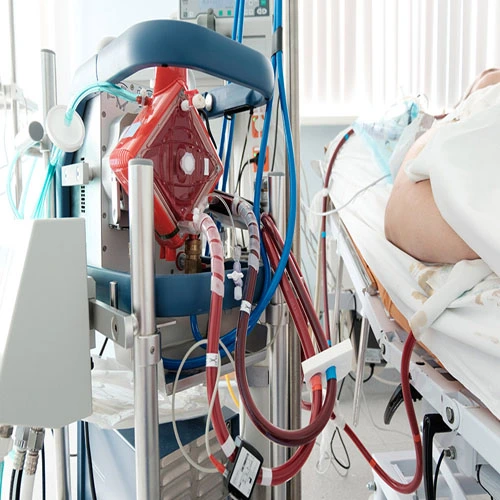- Home
- Departments
Departments Of ECMO-Management
ECMO-ManagementExtracorporeal membrane oxygenation (ECMO) is a life-saving therapy used to support patients with severe respiratory or cardiac failure when conventional treatments are inadequate. ECMO involves circulating the patient's blood outside the body through a machine that provides oxygenation and carbon dioxide removal, allowing the lungs or heart to rest and recover. ECMO management requires specialized expertise and careful coordination among a multidisciplinary team.
1. Patient Selection: ECMO is typically considered for patients with severe respiratory failure (e.g., ARDS) or cardiac failure (e.g., cardiogenic shock) who have failed conventional treatments, such as mechanical ventilation or vasopressor support. Patient selection is based on clinical criteria, severity of illness, underlying pathology, and likelihood of recovery with ECMO support.
2. Cannulation and Circuit Setup: Cannulation involves inserting large-bore catheters (cannulae) into central blood vessels, typically the femoral vein and artery for veno-venous ECMO (respiratory support) or the femoral artery and vein or the internal jugular vein and artery for veno-arterial ECMO (cardiac support). The ECMO circuit includes a pump to circulate blood, a membrane oxygenator to exchange gases, and tubing with connectors and filters. Proper setup and priming of the ECMO circuit are essential to ensure adequate blood flow and gas exchange.
3. ECMO Initiation: ECMO is initiated in the intensive care unit (ICU) under the supervision of a trained ECMO specialist or intensivist. The patient's condition is closely monitored during ECMO initiation, and adjustments are made to optimize blood flow, gas exchange, and hemodynamic stability. Anticoagulation therapy is initiated to prevent clotting within the ECMO circuit.
4. Ventilator Management: In veno-venous ECMO, mechanical ventilation is often continued to provide additional respiratory support, although ventilator settings may be adjusted to minimize lung injury. In veno-arterial ECMO, ventilation may be reduced or discontinued if the patient's respiratory function improves. Careful coordination between the ECMO team and the respiratory therapist is essential to optimize ventilator management during ECMO support.
5. Hemodynamic Support: In veno-arterial ECMO, ECMO provides circulatory support in addition to respiratory support. Close monitoring of hemodynamic parameters, such as blood pressure, cardiac output, and tissue perfusion, is essential to prevent complications such as limb ischemia or hemorrhage. Vasopressors or inotropes may be required to maintain hemodynamic stability.
6. Anticoagulation Management: Anticoagulation therapy is essential to prevent clotting within the ECMO circuit, which can lead to circuit dysfunction or thromboembolic complications. Anticoagulation protocols are tailored to each patient's coagulation status and may involve continuous infusion of heparin or alternative anticoagulants. Regular monitoring of coagulation parameters, such as activated clotting time (ACT) or anti-factor Xa levels, guides anticoagulation therapy titration.
7. Complications and Monitoring: ECMO management involves vigilant monitoring for complications, including bleeding, thrombosis, hemolysis, infection, and circuit malfunction. Close coordination among the ECMO team, nursing staff, and other healthcare providers is essential to detect and manage complications promptly. Advanced monitoring techniques, such as transesophageal echocardiography (TEE) or bedside ultrasound, may be used to assess ECMO flow, cardiac function, and vascular access.
8. Weaning and Decannulation: ECMO support is gradually weaned as the patient's condition improves and organ function recovers. Weaning protocols involve reducing ECMO flow rates or ventilator support while closely monitoring the patient's clinical status and hemodynamic parameters. Once the patient meets predefined criteria for ECMO discontinuation, such as adequate oxygenation and hemodynamic stability, decannulation is performed under sterile conditions.
9. Rehabilitation and Follow-up: Following ECMO support, patients require comprehensive rehabilitation to regain strength, mobility, and functional independence. Long-term follow-up is essential to monitor for complications, assess recovery of organ function, and address physical, psychological, and social needs.
ECMO management requires a highly skilled and experienced multidisciplinary team, including ECMO specialists, intensivists, perfusionists, respiratory therapists, nurses, pharmacists, and rehabilitation specialists. By providing timely and expert care, ECMO can improve outcomes for critically ill patients with severe respiratory or cardiac failure.

